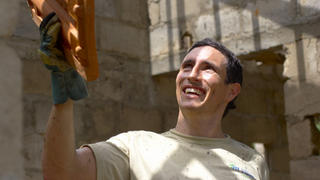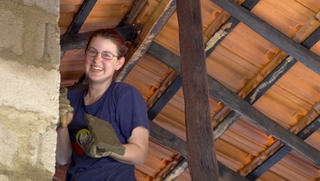Raising the Roof
Our first on the job building houses and we reached a symbolic and tangible achievement as every single member of the team pitched in to finish the roof. The team has transformed itself from an unkown potential to an effective building machine.

Today was a very big day for me, the one I thought would be the most difficult. I simply did not know what to expect. We had been cautioned over and over again to minimise our expectations for the house building. So many factors come into play which may prevent us from being productive. Unforseen interuptions to people, tools and basic materials can cause havoc to the building schedule and generate a lot frustration for the international teams. The idea that you will turn up at an empty plot of land and six days later leave behind a fully constructed home is not realistic.
In our case there were four houses to work on and they were all well and truly under way. Each of the four buildings were in similar stages of completion, with all the walls put up using mortar and concrete bricks. Two had completed roofs and were ready to concrete plaster the walls, one had a roof frame ready for treating and tiling, and the last one was in not yet kitted with even the roof frame. My first impression upon arrival was to wonder how I might be useful given the mature stage of the project - but I need not have worried as the Habitat projects are well rehearsed in putting idle hands to work.
Our Intrepid Challenges team is a little different from the usual Habitat scenario, which would send teams of 8-10 people to a location to work on two houses at a time. Any more than four people on a work-site and everyone starts tripping over each other. We spread out a total of 24 travellers and leaders across the four houses and let people get down to business. Roof battens had to be sawed for joining, roof frames had to be taken to with brush and preserving oil, cement plaster had to be slapped on and smoothed over, bags of cement had to be unloaded and carted about, and great piles of sand was in need of sifting before the cement plaster could be prepared.

The work sites are run by a Habitat appointed construction supervisor, and he was accompanied by Habitat volunteers and the very people for whom we are building the house. This collection of local people provide the expertise and knowledge that ensures the successful completion of the job. It is under their guidance that we try to be useful.
As possibly the least skilled of all our members it was an inspiring site to watch my colleagues. Guys and gals clambered on top of roofs with brush in hand. Exemplary patience and determination was demonstrated by those who dabbed their hand at chucking plaster. Committment and dedication marked the efforts of those who spent all day thrusting sand through a hand made sifter built from 2x4 timber pieces and graded fly-screen. The major obsticle to productivity was confidence, but as the day wore on the change in everyone's self-perception was palpable.
Following the afternoon tea-break something very special happened. House number three was half way through putting on the roofing tiles and the remaining stock of tiles were quite some distance away. The team decided to form a human chain and move all the tiles together. Everyone got into it - the challenge team, the leaders, the construction supervisor, the mums and kids.
As the last tiles went into place we could all stand back and be rightfully proud of a good days work.

Today was a very big day for me, the one I thought would be the most difficult. I simply did not know what to expect. We had been cautioned over and over again to minimise our expectations for the house building. So many factors come into play which may prevent us from being productive. Unforseen interuptions to people, tools and basic materials can cause havoc to the building schedule and generate a lot frustration for the international teams. The idea that you will turn up at an empty plot of land and six days later leave behind a fully constructed home is not realistic.
In our case there were four houses to work on and they were all well and truly under way. Each of the four buildings were in similar stages of completion, with all the walls put up using mortar and concrete bricks. Two had completed roofs and were ready to concrete plaster the walls, one had a roof frame ready for treating and tiling, and the last one was in not yet kitted with even the roof frame. My first impression upon arrival was to wonder how I might be useful given the mature stage of the project - but I need not have worried as the Habitat projects are well rehearsed in putting idle hands to work.
Our Intrepid Challenges team is a little different from the usual Habitat scenario, which would send teams of 8-10 people to a location to work on two houses at a time. Any more than four people on a work-site and everyone starts tripping over each other. We spread out a total of 24 travellers and leaders across the four houses and let people get down to business. Roof battens had to be sawed for joining, roof frames had to be taken to with brush and preserving oil, cement plaster had to be slapped on and smoothed over, bags of cement had to be unloaded and carted about, and great piles of sand was in need of sifting before the cement plaster could be prepared.

The work sites are run by a Habitat appointed construction supervisor, and he was accompanied by Habitat volunteers and the very people for whom we are building the house. This collection of local people provide the expertise and knowledge that ensures the successful completion of the job. It is under their guidance that we try to be useful.
As possibly the least skilled of all our members it was an inspiring site to watch my colleagues. Guys and gals clambered on top of roofs with brush in hand. Exemplary patience and determination was demonstrated by those who dabbed their hand at chucking plaster. Committment and dedication marked the efforts of those who spent all day thrusting sand through a hand made sifter built from 2x4 timber pieces and graded fly-screen. The major obsticle to productivity was confidence, but as the day wore on the change in everyone's self-perception was palpable.
Following the afternoon tea-break something very special happened. House number three was half way through putting on the roofing tiles and the remaining stock of tiles were quite some distance away. The team decided to form a human chain and move all the tiles together. Everyone got into it - the challenge team, the leaders, the construction supervisor, the mums and kids.
As the last tiles went into place we could all stand back and be rightfully proud of a good days work.

0 Comments:
Post a Comment
<< Home